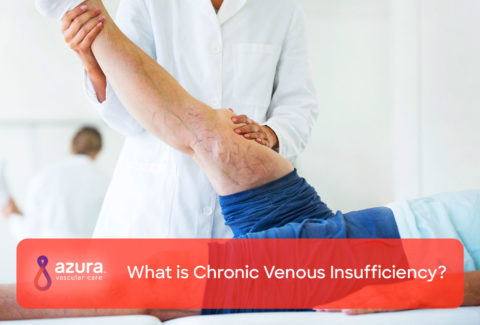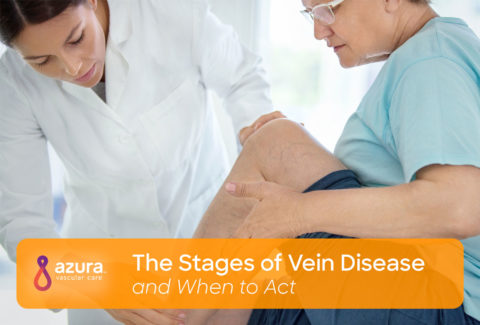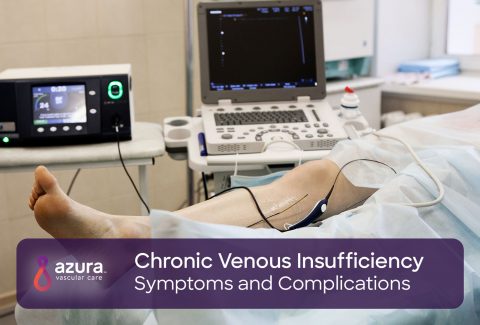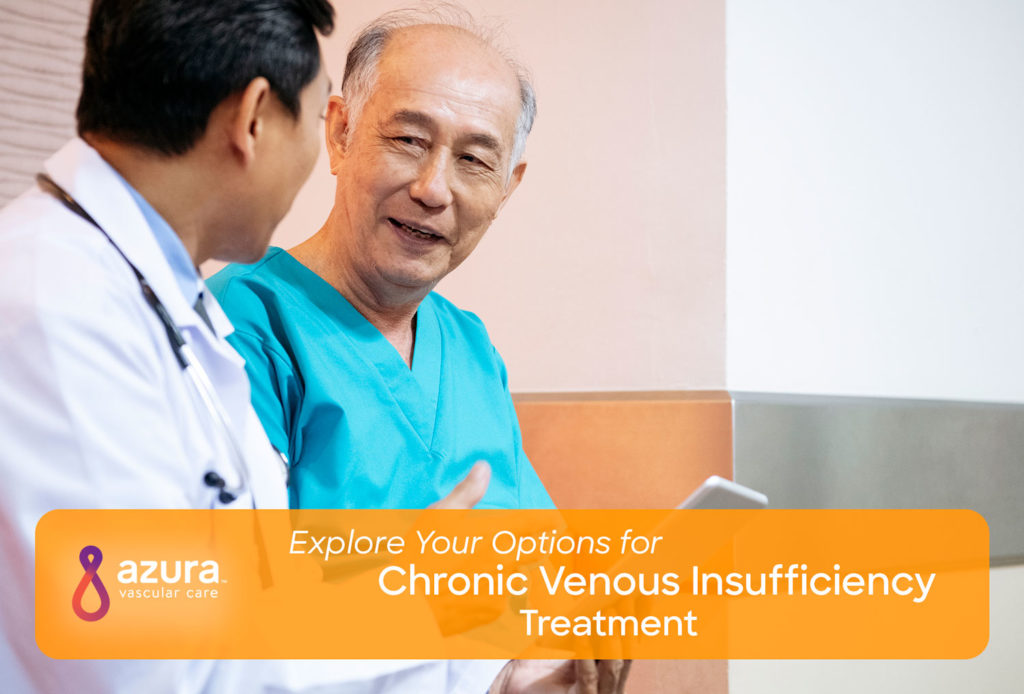
If you have chronic venous insufficiency, you don’t have to suffer alone. Modern treatments can help resolve your symptoms and prevent your condition from progressing. Minimally invasive procedures close off malfunctioning veins and improve blood flow without an overnight hospital stay. Read on to learn more about your options for chronic venous insufficiency treatment.
What Is Chronic Venous Insufficiency?
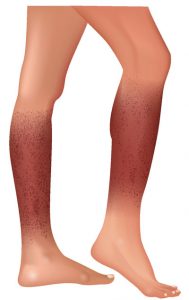 Chronic venous insufficiency is a vascular condition which develops when the valves in your veins do not function properly. In healthy veins, valves direct blood flow. They return deoxygenated blood from your legs back to your heart. Sometimes, these valves become damaged and do not work as well as they should. Instead of returning all deoxygenated blood back to the heart, some blood may flow backward into the legs. (i)
Chronic venous insufficiency is a vascular condition which develops when the valves in your veins do not function properly. In healthy veins, valves direct blood flow. They return deoxygenated blood from your legs back to your heart. Sometimes, these valves become damaged and do not work as well as they should. Instead of returning all deoxygenated blood back to the heart, some blood may flow backward into the legs. (i)
Over time, chronic venous insufficiency causes the veins in the legs to become swollen and distended. Backed-up blood flow can weaken the malfunctioning veins even further. Chronic venous insufficiency is a progressive disease. (ii) That means it becomes worse if it’s not treated. The condition is also sometimes linked with blood clots, which can cause dangerous health complications. That’s why it’s crucial to seek early treatment for your chronic venous insufficiency.
Stages of Chronic Venous Insufficiency
The Clinical-Etiology-Anatomy-Pathophysiology (CEAP) classification system categorizes chronic venous insufficiency symptoms. (iii) Doctors use this classification scale to determine how severe your symptoms are and what kind of treatment you might need.
- C0 Stage: Patients at this stage might have some symptoms, like heaviness or aching in the legs, but no visible signs of chronic venous insufficiency. This is the least severe stage.
- C1 Stage: Patients at this stage have thin visible veins that may resemble spider webs. Chronic venous insufficiency may be present if other symptoms such as pain, swelling or heaviness in the legs are present.
- C2 Stage: Patients at this stage have visibly dilated leg veins. Patients may have painful varicose veins.
- C3 Stage: Patients at this stage suffer from edema, or swelling, in the legs and feet. Increased vascular pressure causes fluid to seep from the vein into the surrounding leg tissue. Legs, ankles, and feet may appear puffy or bloated.
- C4 Stage: Patients at this stage often have visibly discolored or inflamed skin. The legs and ankles may appear brownish. The skin may also have red splotches. Some regions of the legs may look scarred or rashy.
- C5 Stage: Patients at this stage have signs of healed ulcers on the legs.
- C6 Stage: Patients at this stage have “active” or open venous ulcers. Ulcers may be swollen or weeping and might become infected. This is the most severe stage.
If a patient begins to develop ulcers, it’s a sign that there’s not enough blood flowing to the legs. When blood flow to the legs is limited, blood clots can form. Infected ulcers may also require surgery or antibiotics. Chronic venous insufficiency treatments can prevent these complications.
Noninvasive Chronic Venous Insufficiency Treatments
In the early stages of chronic venous insufficiency, you might be able to manage your symptoms with conservative treatment strategies, which may include lifestyle changes or other at-home treatments: (iv)
- Elevate your legs: When sitting or lying down, elevate your legs. This helps relieve pressure inside the veins and promotes circulation.
- Maintain good skin hygiene: People with chronic venous insufficiency are at high risk of developing venous ulcers. These sores may become infected. You can prevent infection by keeping your skin clean. Your doctor will tell you how to keep the ulcer from becoming infected. (v) If you suffer from venous insufficiency don’t use any skin creams or bath products without your doctor’s approval.
- Avoid sitting and standing for too long: Symptoms may worsen if you sit or stand for long periods of time. Try to take regular breaks and elevate your feet to reduce blood pressure in your legs. If your job requires you to stand or sit for many hours at a time, you may find it helpful to wear compression stockings.
- Exercise regularly: Regular exercise keeps blood flowing throughout the legs. Healthy blood flow can reduce your risk of complications like venous ulcers. Walking can be particularly beneficial for people with chronic venous insufficiency. Ask your doctor which physical activities are safest for you.
- Consider compression stockings: Compression stockings fit snugly around your legs. They help improve circulation by preventing blood from flowing backward. This can reduce leg pain and swelling in people with chronic venous insufficiency. Ask your doctor before using compression stockings for the first time.
- Maintain a healthy weight: Excess body weight puts additional pressure on the veins in the legs. Extra pounds can worsen chronic venous insufficiency. If you’re overweight, ask your doctor about safe weight loss methods.
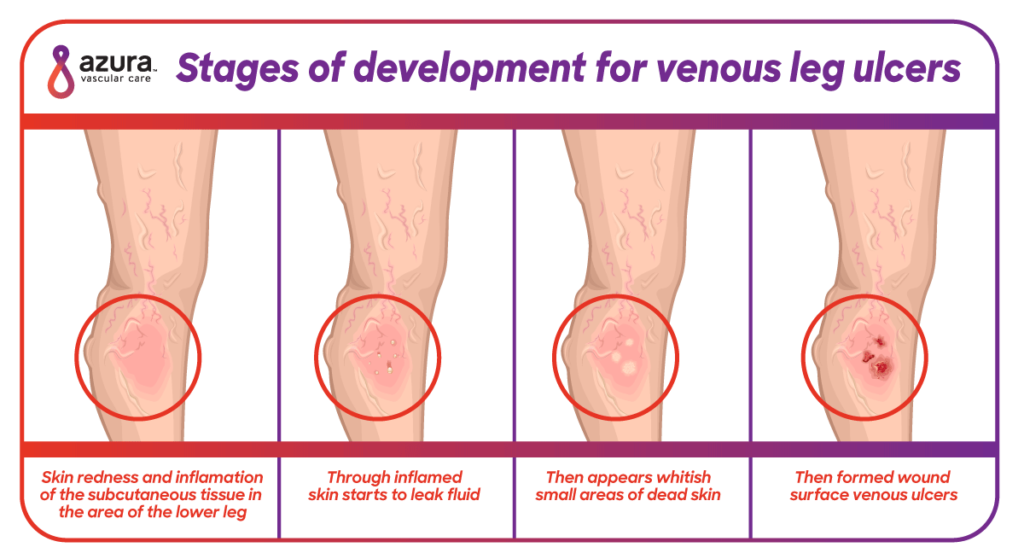
Conservative treatment may be enough to provide relief. If your symptoms worsen, it’s essential that you seek help. A vascular specialist can offer minimally invasive techniques to treat your symptoms and prevent future complications.
Minimally Invasive Chronic Venous Insufficiency Treatments
Minimally invasive procedures can prevent blood from flowing backward in the vein and decrease venous pressure, restoring healthy blood flow to the legs. Treatments for chronic venous insufficiency may include: (vi)
-
- Radiofrequency vein ablation (RVA): RVA uses a tiny catheter to deliver radiofrequency energy into the vein, closing it off. Once the vein is no longer supporting blood flow, it will shrink and be reabsorbed by your body.
- Endovenous laser therapy (EVLT): EVLT is a similar process to RVA. Instead of radiofrequency energy, EVLT uses laser energy to close the affected vein and seal off blood flow. As with RVA, the vein will then shrink and disappear.
- Sclerotherapy: Sclerotherapy uses a medication which is injected into the affected vein. The medicine irritates the tissue and causes scarring. The scarring cuts off blood flow, causing the vein to shrink and fade away.
- Angioplasty and Venous Stripping: If your symptoms are more severe, your vascular specialist may recommend angioplasty or venous stripping. Angioplasty can help open a blocked vein, whereas venous stripping is the removal of a malfunctioning vein.
It can be tempting to put off chronic venous insufficiency treatment. But if you delay treatment, your condition may worsen. Minimally invasive procedures can provide symptomatic relief and get you back to your daily routine quickly. Ready to speak to a doctor about your treatment options? Call 844-832-VEIN (8346) to schedule an appointment with a vascular specialist.
Sources:
(i) John Hopkins Medicine. Chronic venous insufficiency. Retrieved October 1, 2018, from https://www.hopkinsmedicine.org/healthlibrary/conditions/cardiovascular_diseases/chronic_venous_insufficiency_85,P08250.
(ii) MedlinePlus. (2016, June 6). Venous insufficiency. Retrieved October 1, 2018, from https://medlineplus.gov/ency/article/000203.htm.
(iii) Moneta, G. (2018, April 19) Classification of lower extremity chronic venous disorders. In K.A. Collins (Ed.), UpToDate. Retrieved October 1, 2018. https://www.uptodate.com/contents/classification-of-lower-extremity-chronic-venous-disorders?csi=cc3253bf-f8bb-4f0e-a8f8-7a6bd7513422&source=contentShare%20.
(iv) https://my.clevelandclinic.org/health/diseases/16872-chronic-venous-insufficiency-cvi/treatment-options.
(v) MedlinePlus. (2016, May 24). Venous ulcers – self-care. Retrieved October 1, 2018, from https://medlineplus.gov/ency/patientinstructions/000744.htm.
(vi) Mayo Clinic. (2017, December 28). Varicose veins: Diagnosis & treatment. Retrieved October 1, 2018, from https://www.mayoclinic.org/diseases-conditions/varicose-veins/diagnosis-treatment/drc-20350649.

